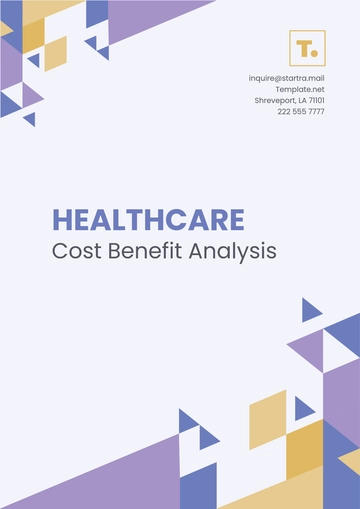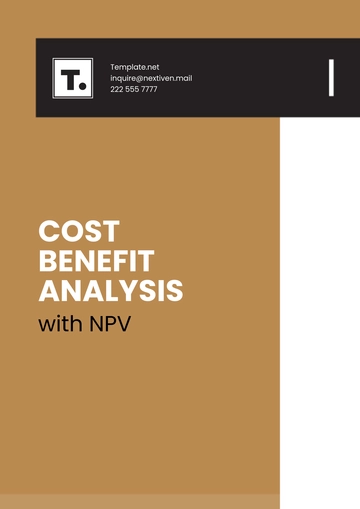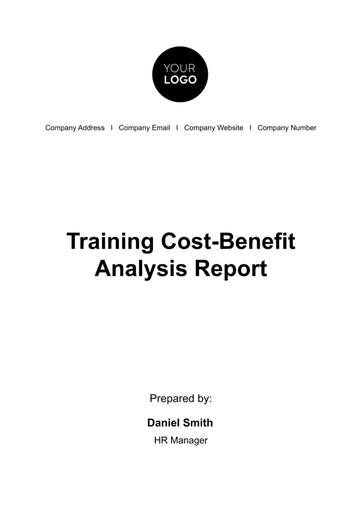Free Travel Agency Budget Analysis

I. Executive Summary
The Travel Agency Budget Analysis for [Your Company Name] provides an overview of the agency's financial plan for the upcoming fiscal year. This report outlines revenue forecasts, expense projections, budget variances, and strategies for cost optimization. By analyzing budgetary aspects, [Your Company Name] aims to ensure financial stability, operational efficiency, and strategic allocation of resources.
II. Introduction
[Your Company Name] is committed to maintaining a sound financial footing while delivering exceptional travel services to its customers. The budget analysis for the upcoming year is crucial for setting financial goals, identifying potential challenges, and devising strategies to achieve sustainable growth and profitability. This report presents a comprehensive analysis of revenue and expenses to guide [Your Company Name]'s financial decision-making process.
III. Revenue Forecast
The revenue forecast for 2024 is based on market trends, historical data, and anticipated demand. [Your Company Name] expects steady growth in revenue across various service categories, driven by an increase in travel demand as global conditions improve.
Revenue Source | Forecasted Revenue (USD) |
|---|---|
Airline Tickets | $2,800,000 |
Hotel Bookings | $1,400,000 |
Tour Packages | $1,000,000 |
Car Rentals | $700,000 |
Cruise Packages | $500,000 |
Other Services | $300,000 |
Total | $6,700,000 |
Airline Tickets: With an expected revenue of $2,800,000, airline ticket sales are projected to remain the largest revenue source for [Your Company Name]. The forecast takes into account factors such as anticipated air travel demand, route expansions, and pricing strategies to capture market share while maintaining profitability.
Hotel Bookings: Forecasted hotel booking revenue of $1,400,000 reflects [Your Company Name]'s projections for accommodation reservations. Factors influencing this forecast include trends in leisure and business travel, hotel partnerships, and seasonal variations in demand.
Tour Packages: [Your Company Name] anticipates generating $1,000,000 in revenue from tour package sales, catering to travelers seeking curated travel experiences. The forecast considers factors such as popular destinations, emerging travel trends, and package pricing to meet customer preferences and maximize sales.
Car Rentals: Projected car rental revenue of $700,000 reflects [Your Company Name]'s expectations for demand in this segment. Factors such as customer preferences for flexibility and convenience, fleet availability, and pricing competitiveness influence the forecast.
Cruise Packages: [Your Company Name] forecasts revenue of $500,000 from cruise package sales, targeting travelers interested in ocean voyages and cruise vacations. The forecast considers factors such as cruise line partnerships, itinerary offerings, and promotional activities to stimulate demand and drive sales.
Other Services: Revenue from other services, including travel insurance, visa assistance, and ground transportation, is forecasted at $300,000. This category encompasses supplementary services that complement [Your Company Name]'s core offerings and contribute to overall revenue diversification.
IV. Expense Projection
The expense projection for 2024 includes costs related to marketing, personnel, technology investments, overhead expenses, and training & development initiatives. [Your Company Name] aims to manage expenses effectively while ensuring adequate resources are allocated to support business operations and growth initiatives.
Expense Category | Projected Expense (USD) |
|---|---|
Marketing | $600,000 |
Personnel | $450,000 |
Technology | $350,000 |
Overhead | $300,000 |
Training & Development | $200,000 |
Total | $1,900,000 |
Marketing: With a projected expense of $600,000, [Your Company Name] aims to allocate resources to strategic marketing initiatives aimed at enhancing brand visibility, attracting new customers, and retaining existing clientele. Investments in digital marketing, advertising campaigns, and promotional activities are essential to driving sales and revenue growth.
Personnel: Projected personnel expenses of $450,000 encompass salaries, wages, benefits, and incentives for [Your Company Name]'s workforce. Strategic allocation of personnel resources ensures adequate staffing levels to meet operational demands, deliver quality customer service, and support business objectives while optimizing labor costs.
Technology: [Your Company Name] plans to invest $350,000 in technology infrastructure, including software, hardware, and IT solutions. These investments support operational efficiency, enhance customer experience, and enable innovation in booking systems, website functionality, and digital platforms to remain competitive in the evolving travel industry landscape.
Overhead: Overhead expenses of $300,000 cover general operational costs such as rent, utilities, insurance, and administrative expenses. Managing overhead costs effectively is essential to maintaining financial stability and ensuring profitability while providing a conducive working environment for [Your Company Name]'s operations.
Training & Development: [Your Company Name] allocates $200,000 for training and development initiatives aimed at enhancing employee skills, knowledge, and performance. Investing in training programs, professional development opportunities, and skill-building workshops contributes to employee satisfaction, retention, and overall service quality, supporting [Your Company Name]'s growth and success.
V. Budget Variance Analysis
The budget variance analysis compares budgeted amounts with actual figures to assess financial performance and identify areas of improvement. Variance analysis enables [Your Company Name] to track deviations from the budget and take corrective actions to ensure financial objectives are met.
Category | Budgeted Amount (USD) | Actual Amount (USD) | Variance (USD) | Variance (%) |
|---|---|---|---|---|
Revenue | $6,700,000 | $6,500,000 | -$200,000 | -3% |
Expenses | $1,900,000 | $1,850,000 | -$50,000 | -2.6% |
Net Income | $4,800,000 | $4,650,000 | -$150,000 | -3.1% |
Revenue: The actual revenue of $6,500,000 falls short of the budgeted amount by $200,000, representing a negative variance of 3%. Factors contributing to this variance may include lower-than-expected sales volumes, pricing pressures, or changes in market conditions. [Your Company Name] will need to investigate the root causes of the revenue shortfall and implement strategies to mitigate the impact, such as targeted marketing campaigns, sales incentives, or product/service enhancements.
Expenses: Actual expenses amount to $1,850,000, which is $50,000 less than the budgeted amount, resulting in a variance of -2.6%. While this represents a favorable variance, [Your Company Name] should ensure that cost-saving measures do not compromise operational efficiency or service quality. Continuously monitoring expenses, optimizing resource utilization, and identifying areas for cost reduction without sacrificing strategic priorities will be essential to maintaining financial health and profitability.
Net Income: The net income of $4,650,000 is $150,000 lower than the budgeted amount, representing a negative variance of 3.1%. Despite the revenue and expense variances, [Your Company Name] still maintains a healthy net income. However, proactive measures to address the revenue shortfall and optimize expenses will be necessary to minimize the impact on profitability and ensure that financial targets are met.
VI. Cost Optimization Strategies
Effective cost optimization is essential for [Your Company Name] to maintain financial health, maximize profitability, and remain competitive in the travel industry. By identifying opportunities to streamline operations, reduce expenses, and improve efficiency, [Your Company Name] can achieve sustainable growth and ensure long-term success. The following strategies outline key initiatives to optimize costs while maintaining service quality and customer satisfaction:
Marketing Efficiency: Focus on high-impact marketing strategies such as targeted advertising, content marketing, and referral programs to maximize return on investment (ROI) and minimize marketing costs.
Operational Streamlining: Implement process improvements and automation tools in operations, booking systems, and customer service functions to enhance efficiency, reduce administrative overheads, and lower operational costs.
Vendor Negotiations: Negotiate favorable terms and contracts with suppliers, airlines, hotels, and other partners to secure discounts, rebates, and incentives, resulting in cost savings and improved profitability.
Personnel Productivity: Optimize staffing levels, improve employee productivity, and incentivize performance to minimize labor costs while maintaining service quality and customer satisfaction.
Technology Optimization: Evaluate and leverage technology solutions to optimize IT infrastructure, enhance online booking systems, and automate repetitive tasks, leading to increased efficiency and reduced operational costs.
Inventory Management: Implement effective inventory management practices to minimize excess inventory, avoid stockouts, and optimize procurement processes, reducing carrying costs and improving cash flow.
Energy Efficiency: Adopt energy-efficient practices and technologies to reduce utility expenses, such as energy-efficient lighting, HVAC systems, and office equipment, leading to long-term cost savings and environmental benefits.
Supplier Consolidation: Consolidate purchases and streamline supplier relationships to leverage economies of scale, negotiate better pricing, and reduce transaction costs across multiple suppliers and vendors.
These cost optimization strategies enable [Your Company Name] to enhance financial performance, strengthen competitiveness, and position itself for sustainable growth and success in the dynamic travel industry landscape.
VII. Conclusion
In conclusion, the Travel Agency Budget Analysis provides valuable insights into [Your Company Name]'s financial planning and management strategies for the upcoming fiscal year. By forecasting revenue, projecting expenses, analyzing budget variances, and outlining cost optimization strategies, [Your Company Name] aims to ensure financial stability, operational efficiency, and strategic allocation of resources. The analysis highlights opportunities for revenue growth, expense optimization, and enhancement of profitability while addressing challenges and uncertainties in the travel industry landscape.
Overall, the Travel Agency Budget Analysis serves as a roadmap for [Your Company Name]'s financial decision-making process, guiding strategic initiatives and resource allocation to support sustainable growth, maximize profitability, and maintain competitiveness in the dynamic and ever-changing travel industry. Through prudent financial management, effective cost optimization, and strategic investments, [Your Company Name] is well-positioned to navigate challenges, seize opportunities, and achieve long-term success in delivering exceptional travel experiences to its customers.
- 100% Customizable, free editor
- Access 1 Million+ Templates, photo’s & graphics
- Download or share as a template
- Click and replace photos, graphics, text, backgrounds
- Resize, crop, AI write & more
- Access advanced editor
Effectively manage finances with Template.net's Travel Agency Budget Analysis Template. Editable in our AI Editor Tool, this readily customizable template offers a structured format for analyzing budget allocations, expenditures, and variances within your agency. Enhance financial planning, identify areas for cost savings, and optimize resource utilization with this user-friendly template!





























